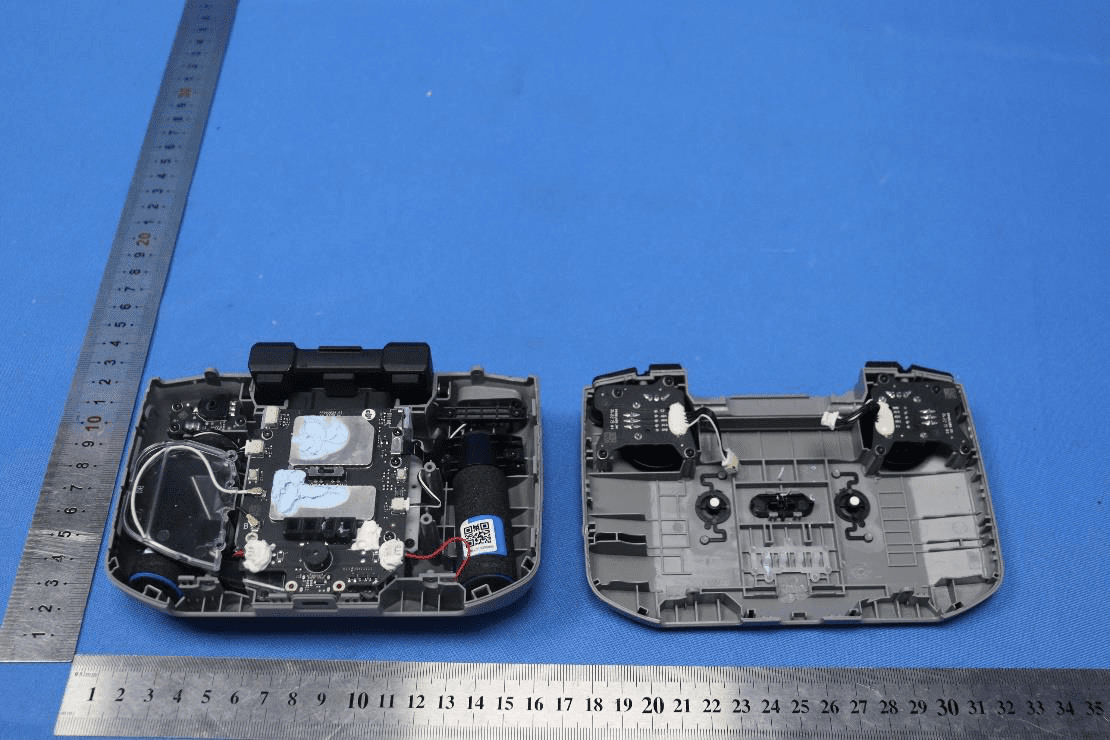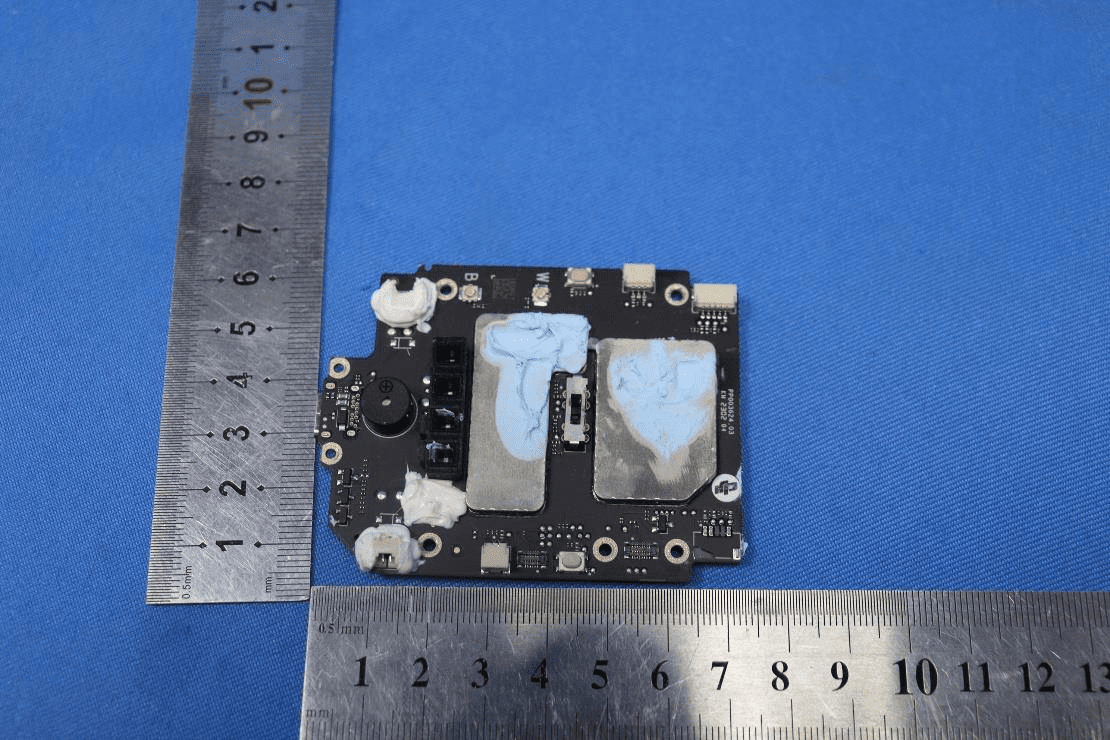Introduction
The DJI Air 3, developed by SZ DJI TECHNOLOGY CO., LTD. (Model: EB3WBC), stands at the forefront of consumer drone technology, blending advanced flight capabilities with sophisticated imaging systems. Designed for aerial photography, videography, and intelligent flight, the DJI Air 3 combines robust engineering with user-focused features, making it a powerful tool for enthusiasts and professionals alike.
A pivotal milestone for any wireless device in the United States is Federal Communications Commission (FCC) certification. The DJI Air 3, under FCC ID SS3-RC1512303, has successfully met stringent RF emission and electromagnetic compatibility standards. This certification not only authorizes the device for sale and operation in the U.S. market but also signifies that it adheres to national regulations for radio frequency exposure and interference.
In this article, we dive deep into the DJI Air 3’s key specifications, wireless technologies, internal components, and regulatory compliance. Through detailed teardown analysis and insights from official documentation, we reveal what sets this drone apart in a competitive landscape.
Key Features & Specifications
The DJI Air 3 is engineered to deliver high-performance flight, reliable connectivity, and stunning imaging—all in a compact, modular package. Below, we break down its standout features and technical specifications, highlighting the real-world benefits for users.
Key Features
- Battery Buckles
Secure the Intelligent Flight Battery in place, ensuring safe operation and easy swapping during field use. - Propellers
Precision-engineered for optimal lift and quiet operation, facilitating stable, efficient flight and agile maneuvers. - Dongle Compartment Cover
Protects ports and connectors, maintaining the integrity of internal electronics while allowing for quick accessory changes. - Gimbal and Camera System
- Tele Camera: Enables high-quality zoomed shots, ideal for capturing distant subjects without loss of detail.
- Wide Camera: Captures expansive landscapes and immersive aerial perspectives.
- Horizontal Omnidirectional Vision System
Provides advanced obstacle detection and avoidance in all horizontal directions, enhancing flight safety and enabling intelligent navigation. - Downward Vision System
Assists with precision landings and stable hovering by analyzing ground patterns and altitude. - Intelligent Flight Battery
- Model: BWX233-4241-14.76
- Capacity: 4241 mAh
- Offers extended flight times and intelligent monitoring for battery health and safety.
- Infrared Sensing System
Adds another layer of obstacle detection, particularly effective in low-light or complex environments.
Technical Specifications
- Wireless Communication
- Wi-Fi Standards: 802.11a/b/g/n/ac
- Frequency Bands: 2.400–2.4835 GHz, 5.15–5.25 GHz, 5.725–5.850 GHz
- Transmitter Power (EIRP):
- 2.4 GHz: <23 dBm (FCC), <20 dBm (CE/SRRC/MIC)
- 5.8 GHz: <23 dBm (FCC/SRRC), <14 dBm (CE)
- Bluetooth: Present (specific version not detailed)
- Remote Controller
- Operating Frequency: 2.400–2.4835 GHz; 5.725–5.850 GHz
- Operating Temperature: -10 to 40°C (14° to 104°F)
- Battery System
- Capacity: 4241 mAh (Intelligent Flight Battery)
- Smart Monitoring: Provides real-time status, optimizing safety and longevity
- Environmental Tolerance
- Operating Temperature: -10 to 40°C (14° to 104°F)
Practical Implications
These features and specifications enable the DJI Air 3 to excel in real-world scenarios, from high-resolution aerial photography to precise, autonomous missions. The advanced vision and sensing systems work in concert with robust wireless connectivity, ensuring reliable command, control, and data transmission even in challenging environments. Intelligent battery management and rugged design further support extended, dependable operation.
Operating Frequencies
The DJI Air 3, as certified under FCC ID SS3-RC1512303, operates across a range of frequency bands and power levels, as detailed in its FCC filing. These parameters are vital for understanding its wireless performance, range, and compliance with regulatory standards.
| Frequency Range (GHz) | Output Power (mW) | FCC Rule Part |
|---|---|---|
| 2.4035–2.46912 | 352.4 | 15CCC |
| 2.4045–2.4695 | 588.8 | 15CCC |
| 5.7655–5.8095 | 245.5 | 15ECC |
| 2.4075–2.4675 | 602.6 | 15CCC |
| 5.17–5.23 | 77.4 | 15ECC |
| 2.4055–2.4682 | 583.4 | 15CCC |
| 5.7275–5.8472 | 623.7 | 15ECC |
| 2.4125–2.4625 | 626.6 | 15CCC |
| 5.7305–5.8445 | 636.8 | 15ECC |
| 2.4225–2.4525 | 122.5 | 15CCC |
| 5.7285–5.84612 | 575.4 | 15ECC |
| 2.4325–2.4425 | 28.8 | 15CCC |
| 5.7355–5.8395 | 629.5 | 15ECC |
| 5.161–5.24 | 86.3 | 15ECC |
| 5.7325–5.8425 | 606.7 | 15ECC |
| 5.7455–5.8295 | 309 | 15ECC |
| 5.7555–5.8195 | 221.3 | 15ECC |
These frequency bands and associated power levels enable the DJI Air 3 to leverage various wireless technologies, maintain robust links between the aircraft and remote controller, and comply with limits set forth by FCC Rule Parts 15CCC and 15ECC.
Technology Deep Dive
The DJI Air 3 leverages a suite of advanced wireless technologies to deliver reliable, low-latency communication and enhanced user experiences. Its primary wireless connectivity is built on dual-band Wi-Fi (2.4 GHz and 5.8 GHz), supporting 802.11a/b/g/n/ac protocols for high-speed data transfer and robust command/control links. The device also incorporates Bluetooth for short-range communication, likely supporting quick pairing and auxiliary functions.
Operating within the specified frequency bands, the DJI Air 3 ensures optimal balance between range, throughput, and interference resistance. The 2.4 GHz band offers extended range and better penetration through obstacles, while the 5.8 GHz band provides higher data rates and reduced congestion—essential for transmitting high-quality video feeds and telemetry.
The output power levels, as detailed in the FCC filing, are carefully regulated to maximize wireless performance while minimizing interference with other devices and remaining within safe RF exposure limits. The sophisticated antenna design, evident from internal component analysis, further enhances signal integrity and reliability, even in complex environments.
Advanced RF design, including meticulous PCB layout, shielding, and grounding strategies, ensures electromagnetic compatibility and robust operation. The result is a system capable of maintaining stable connections, supporting intelligent flight modes, and delivering seamless real-time video and control.
In-Depth Internal Component Analysis / Teardown
Main PCB Assembly: Processing and RF Core
A detailed examination of the remote controller’s internal electronics reveals a meticulously engineered main PCB at the heart of the system. The board features two prominent integrated circuits under thermal pads—likely the main system-on-chip (SoC) and an RF transceiver or baseband processor—responsible for managing flight commands, real-time video processing, and wireless communication. The high component density, presence of numerous ground vias, and differential pair routing all point to a multilayer board optimized for high-speed data and RF integrity. Multiple coaxial cables connect the PCB to what are likely embedded antennas, facilitating robust dual-band Wi-Fi and proprietary RF links. The inclusion of FPC connectors, tactile switches, joystick modules, and a vibration motor supports a rich user interface, while the cylindrical battery cell and local power regulation components ensure stable operation. The overall build demonstrates DJI’s commitment to thermal management, EMI control, and serviceability, with modular design choices that reflect an advanced, user-focused remote controller architecture.

Drone Flight Controller: Shielded Processing & Power Domains
The drone’s internal processing board exemplifies high-density, high-performance embedded design. Two large ICs, protected by robust metal shields and thermal interface material, suggest these are the primary processing and wireless communication hubs—the SoC and RF/power management ICs. The PCB itself is likely a 6–8 layer construction, evident from the dense via patterns and compact layout. Clear separation of analog/RF and digital domains, along with extensive EMI/RFI shielding, ensures minimal interference and reliable operation of critical systems. Multiple FPC connectors facilitate integration with cameras, sensors, and other subsystems, enabling the sophisticated vision and navigation features described earlier. Local power regulation is handled by sizable capacitors and inductors, while the presence of crystals and oscillators supports precise timing for wireless and sensor operations. Adhesive reinforcement and test points underscore the focus on mechanical robustness and maintainability, essential for a drone operating in dynamic, vibration-prone environments. This board is a testament to DJI’s engineering excellence in balancing processing power, RF performance, and mechanical reliability.

Shielded drone controller PCB with SoC and RF/power domains.
Regulatory Insights & FCC Filing
The FCC ID SS3-RC1512303 assigned to the DJI Air 3 signifies full compliance with U.S. electromagnetic interference and RF exposure standards. This certification, granted by the FCC, not only authorizes the device for legal sale and operation in the United States but also assures users that the Air 3 meets stringent safety and interference limits.
FCC filings for devices like the DJI Air 3 typically encompass a range of documentation: exhaustive test reports for RF emissions and exposure, electromagnetic compatibility (EMC) results, internal and external photographs, user manuals, block diagrams, and schematics. These materials collectively demonstrate how the product adheres to regulatory requirements and industry best practices.
Insights from the user manual highlight a comprehensive overview of the Air 3’s main components, operation procedures, and technical specifications, ensuring users can operate the device safely and effectively. Test documentation confirms that the wireless systems, including Wi-Fi and Bluetooth, function within prescribed frequency and power limits. Internal documentation reveals a strong emphasis on EMI mitigation, thermal management, and robust wireless design—key factors in achieving FCC approval. This thorough approach to compliance and engineering underscores DJI’s reputation for reliability and regulatory diligence.
Potential Use Cases & Target Audience
The DJI Air 3’s advanced feature set and robust wireless architecture make it a versatile tool for a wide range of users:
- Aerial Photography and Cinematography
With its dual-camera system (tele and wide), omnidirectional vision, and intelligent flight features, the Air 3 is ideal for content creators seeking cinematic aerial shots, dynamic tracking, and creative perspectives. - Surveying and Mapping Professionals
The drone’s precise navigation, downward vision system, and reliable long-range communication enable accurate mapping and surveying tasks, even in challenging environments. - Tech Enthusiasts and Hobbyists
The Air 3’s modular design, intuitive controls, and advanced obstacle avoidance provide an accessible yet powerful platform for drone enthusiasts interested in both recreational flying and technical exploration.
While the Air 3 is engineered for a broad audience, its blend of sophistication and user-friendliness ensures it meets the needs of both demanding professionals and ambitious hobbyists.
Conclusion
The DJI Air 3 by SZ DJI TECHNOLOGY CO., LTD. (Model: EB3WBC) represents a benchmark in consumer drone technology, combining advanced imaging, intelligent flight features, and robust wireless connectivity. Its FCC certification under ID SS3-RC1512303 confirms regulatory compliance and market readiness in the United States. Detailed teardown analysis reveals a meticulously engineered device, with careful attention to RF performance, thermal management, and mechanical reliability. Whether for creative, professional, or recreational use, the DJI Air 3 stands out as a top-tier choice, reflecting DJI’s commitment to innovation and quality in the aerial technology market.